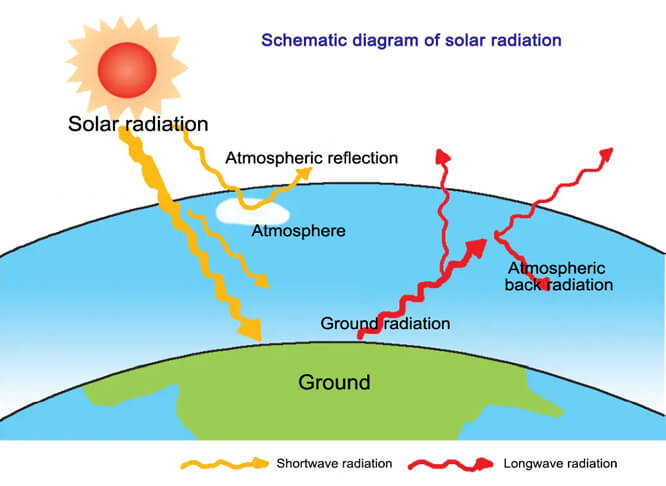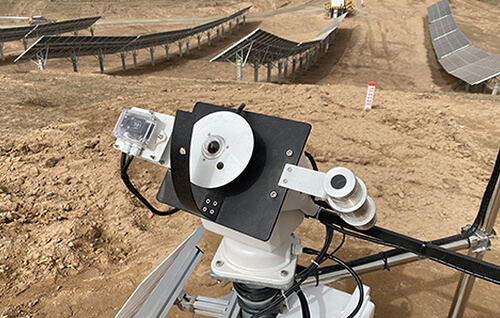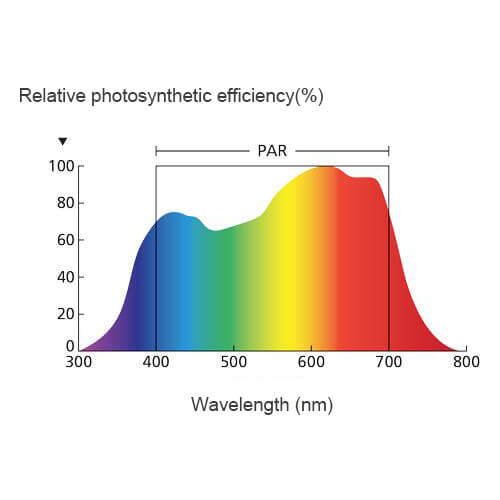What is solar radiation?
Solar radiation is the energy emitted by the sun into the surrounding space in the form of electromagnetic waves. The energy transmitted by solar radiation is solar radiation energy. The radiation received by the Earth is only one part in 2.2 billion of the total radiant energy emitted by the Sun into the universe, but it is the main source of energy for the movement of the Earth’s atmosphere, as well as the main source of the Earth’s light and heat energy.
Meteorologically, we refer to solar radiation as shortwave radiation and the radiation released by the ground and atmosphere as longwave radiation. At present, there are many products in the world that provide solar radiation data from all over the world with high accuracy. Solar radiation can be divided into total solar radiation received by the surface, reflected solar radiation, and net radiation received by the surface.

How does solar radiation affect climate?
Solar radiation reaches the earth’s surface in the form of light and heat. Due to the moderate distance between the earth and the sun, the earth’s shape and the existence of the obliquity of the ecliptic, the distribution of sun radiation reaching the earth’s surface is uneven.
The uneven distribution of solar radiation in space causes different thermal conditions at different latitudes of the earth, forming global pressure belts and planetary wind systems, causing the earth’s atmosphere to move in three dimensions. Solar radiation causes water on the earth’s surface to evaporate, and with atmospheric movement, water vapor is transported, and eventually returns to the earth’s surface in the form of rainfall.
Under the influence of solar radiation and atmospheric movement, global waters form water cycles between sea and land and water cycles within the ocean or land. Rocks on the earth’s surface are exposed to solar radiation, warming up during the day and cooling down at night, and disintegrating and weathering under the combined action of wind and precipitation. The products formed by weathering are transported by wind, flowing water, etc. to form sedimentary rocks.
What are factors affecting solar radiation?
Solar radiation intensity refers to the strength of sun radiation reaching the ground. Solar radiation is absorbed, reflected and scattered by the atmosphere, and by the time it reaches the ground it has been drastically reduced. In addition, there are many factors that affect the strength of sun radiation, making the sun radiation reaching different regions different.
1. Latitude position
The solar altitude angle at noon is large in places with low latitudes, and the distance of solar radiation passing through the atmosphere is short, so it is less weakened by the atmosphere, and the sun radiation reaching the ground is more. On the contrary, the radiation in places with high latitudes is weaker. This is the main reason why sun radiation decreases from low latitudes to high latitudes.
The orbit of the earth’s revolution around the sun is elliptical, and the sun is located at one of the two foci. Therefore, the distance between the sun and the earth is constantly changing. It passes the perihelion from January 2 to 5 every year, and the aphelion from July 3 to 4. The intensity of sun radiation received on the earth is inversely proportional to the square of the distance between the sun and the earth. The angle between the sun’s rays and the horizon is solar altitude angle, which varies daily and annually. The larger the solar altitude angle, the stronger the sun radiation.
2. Weather conditions
There are few clouds in a clear sky, and the atmosphere has a weak weakening effect on solar radiation, so the radiation reaching the ground is strong. There are many clouds in rainy weather, and the atmosphere has a strong weakening effect on solar radiation, so the radiation reaching the ground is weak. For example, the equatorial region is controlled by the equatorial low pressure belt, and there are more convective rains. The subtropical region is controlled by the subtropical high pressure belt, and there are more clear weather. Therefore, the radiation in the equatorial region is weaker than that in the subtropical region.
3. Altitude
At high altitudes, the air is thin, and the weakening effect of the atmosphere on sun radiation is weak, so the sun radiation reaching the ground is strong. In contrast, the sun radiation in areas with low altitudes is weak. The Qinghai-Tibet Plateau is the area with the strongest solar radiation in China, mainly for this reason.
4. Sunshine time
Regions with long sunshine time can obtain more solar radiation than those with short sunshine time. The length of daylight in all four seasons on the equator is 12 hours, and the length of daylight outside the equator varies with the seasons. The length of daylight on the spring and autumn equinoxes at 23.5° latitude is 12 hours, and the length of daylight on the summer solstice and winter solstice is 14 hours and 51 minutes and 9 hours and 09 minutes respectively. At 66°33′ latitude, polar day and polar night phenomena occur. The winter and summer seasons in the northern and southern hemispheres are opposite.
How to measure solar radiation?
1. Pyranometer
The pyranometer measure direct solar radiation and the radiation that reaches the ground after being scattered by the atmosphere. It works by absorbing radiation and converting it into an electrical signal through a thermopile sensor. The measurement range of the radiometer is usually from a few hundred watts per square meter (W/m²) to a few kilowatts per square meter, which can fully evaluate the intensity of solar radiation on the ground. The Pyranometer can adapt to a variety of environmental conditions and can not only work on sunny days, but also accurately measure radiation changes on rainy days.

2. Pyrheliometer
The pyrheliometer measures the radiation that the sun directly shines on the ground. It works similarly to the pyranometer, both of which use thermopile sensors to sense radiation and convert it into electrical signals. However, it only measures the light that reaches the ground directly from the sun, and the measurement process needs to be aimed at the sun at all times. The measurement range of the pyrheliometer is usually from a few hundred watts per square meter (W/m²) to 1000 watts per square meter, which is suitable for accurate measurement of direct radiation intensity.
What is the difference between a pyranometer and a pyrheliometer?
Measuring range: Pyranometer measures direct radiation from the sun and radiation scattered by the atmosphere. Pyrheliometer only measures direct sun radiation, which is radiation from the sun directly to the instrument.
Measuring process: Pyranometer has a wide field of view (180 degrees) and does not need to be aimed at the sun. Pyrheliometer has a narrow field of view and needs to be always aimed at the sun through a sun tracking system.
Application range: Pyranometer is widely used in solar energy, meteorology and climate research. Pyrheliometer is mainly used for scientific research and precise measurement.
Solar radiation sensor measures solar radiation through the photoelectric effect. Common types include photodiodes and photovoltaic cells. They convert light energy into electric current and then output electrical signals. Unlike traditional radiometers, photodiodes and photovoltaic cells are usually used to measure solar radiation of specific wavelengths, such as visible light or ultraviolet bands. The measurement range is usually between tens to several kilowatts per square meter, depending on the photoelectric components and sensor design used.
4. Spectroradiometer
Spectroradiometer is mainly used to measure the spectral distribution of solar radiation, and can accurately measure the intensity of solar radiation in different wavelength ranges. Its working principle is to disperse the radiation of the light source into components of different wavelengths through a grating or prism, and then use a detector to measure the radiation intensity of each wavelength. The measurement range of the spectroradiometer is very wide, from ultraviolet (UV) to visible light, to infrared (IR), covering almost the entire spectrum of solar radiation.
Application of solar radiation
- Evaluate the efficiency of solar energy use, reasonably install photovoltaic weather stations and solar power supply stations and other equipment, and continuously optimize the design of solar cells.
- Predict weather changes and conduct meteorological research.
- Improve plant photosynthesis and promote agricultural production.
- Provide data reference for public outdoor activities
- Assist in planning urban building design.
- Provide data support for environmental monitoring and protection.
How does solar radiation affect solar panel efficiency?
The intensity and wavelength distribution of radiation affect the efficiency of solar panels. The greater the radiation intensity, the more energy the panel receives and the more electricity it generates. However, a large amount of radiation can also cause the ambient temperature to be too high, reducing the conversion efficiency of the panel, because high temperature can affect the voltage output of the battery.
Secondly, different types of solar cells have different absorption efficiencies for light of different wavelengths. Visible light and near-infrared light contribute the most to the conversion efficiency of solar panels.
Finally, direct and scattered solar radiation can also affect the efficiency of the panel. When encountering a cloudy day dominated by scattered radiation, the efficiency of the panel will be relatively low. Therefore, factors such as the intensity, angle, wavelength and ambient temperature of sun radiation will affect the power generation efficiency of solar panels.
How can I optimize my solar panels based on solar radiation data?
Adjust the orientation of the panels
The radiation intensity at different latitudes is different. By measuring the local radiation data, the orientation of the panels (pitch angle and azimuth) can be reasonably adjusted to maximize the use of sun radiation. Generally, solar panels should face due south (northern hemisphere) or due north (southern hemisphere), and should be adjusted in time according to the radiation data of different seasons.
Install a tracking system
According to real-time solar radiation data, installing a solar tracking system can ensure that the solar panels are always aimed at the sun, thereby maximizing the direct solar radiation received. By using a one-axis or two-axis tracker, the panels can adjust their angles with the movement of the sun to increase power generation.
Choose the best spacing and tilt
The spacing between panels should avoid shadows between adjacent panels. The optimal tilt should be determined based on local radiation data to maximize the absorption of light. The installation position of the panels ensures that there is no shadow.
Choose the best type of panel
Different types of solar panels (such as monocrystalline silicon, polycrystalline silicon, thin-film cells, etc.) have different absorption efficiencies for different wavelengths of light. According to local radiation data, choose the appropriate type of panel. If the local radiation is mainly infrared, then you should choose solar panels that respond better to infrared.











